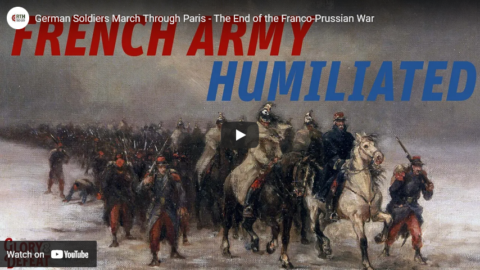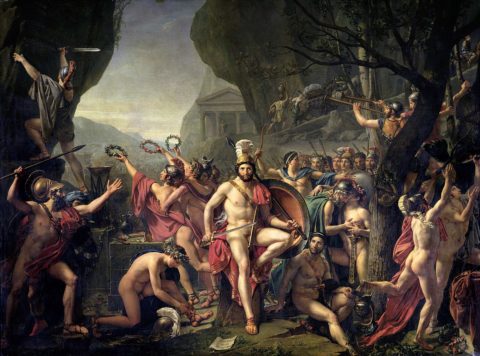World War Two
Published 30 Jan 2022The Battle of Stalingrad is nearing its end. Strong contingents of the 21st and 62nd Soviet Armies broke through the German defensive lines west of Stalingrad and were now pushing deep into the city. Despite the “Kessel” being split into several parts, the Axis soldiers are still resisting fiercely, fighting street by street, house by house. Yet it is a desperate last stand. Overwhelmed and undersupplied, many Generals push for surrender. But only their commander, the freshly promoted “Field-Marshal” Paulus, has the authority to do so.
(more…)
January 31, 2022
Stalingrad: Endgame – WW2 – 179b – January 31, 1943
“Over the span of human history, yelling at someone to ‘Calm down!’ has a failure rate of 100 per cent”
A few days ago, Matt Gurney reported on the trucker convoy just as the first vehicles began to arrive in Ottawa (and the Prime Minister announced he’d been exposed to someone with the Wuhan Coronavirus and would go into isolation).

Posted to Twitter by @KatherineZupan https://twitter.com/KatherineZupan/status/1486164240364814337/photo/1
I don’t remember who said this; I’d give proper credit if I could. But I do remember it made me laugh, largely because it was true. Over the span of human history, yelling at someone to “Calm down!” has a failure rate of 100 per cent.
Two years into this pandemic, Canadians are angry and frustrated and anxious. Much of this is driven by the stress of COVID, but not all of it. There are good reasons to be angry. There are also bad reasons to be angry and right now people from both categories are streaming into our nation’s capital.
As I write this, it is Friday morning. The first protesters have begun to arrive in the capital for a large protest. It’s been described as a trucker convoy, though initial reports suggest many people are arriving in their normal, everyday vehicles. There’s no reliable estimate yet of its size, but while it doesn’t seem to be tracking toward the tens of thousands of vehicles some of its boosters had claimed, it’s clearly large enough. Hundreds of vehicles? Low thousands? We’ll find out. However many there are, though, the people inside them are angry, and they want to be heard.
[…]
I’m a realist. There will always be a fringe — a fringe on both sides of the spectrum. The right-wing fringe, which is the concern today, is fired up and self-sustaining. It’s global in scope and has detached itself so thoroughly from the mainstream that traditional outreach tools like education via media and societal institutions won’t work — the media and the institutions are among the preferred targets of the fringe. You’re not going to talk these guys down by citing the Toronto Star, or, indeed, The Line. The movement can sustain itself on social networks with all the misinfo it can create indefinitely. We’re stuck with it. But if we want to keep it a fringe, we need to isolate it and wall it off by keeping our moderate institutions strong and competent.
And we’re not doing that, are we? The greatest bulwark against expansion of the fringes is a confident, functional centre, and as we often recount here at The Line, Canadian institutions (and many others more generally across the Western world) are in a bit of a state, aren’t they?
We have a military that can’t fight. A federal government that can’t procure pistols for the army or pay its own employees. The best and brightest public health leaders we’ve got told us that the risk to Canada from COVID-19 was low, until it wasn’t, and then they thoroughly botched the response. Inflation is heating up, food insecurity is rising, you can’t buy a house anywhere near one of our major cities unless your parents can spot you the first million bucks, and in much of the country, the schools haven’t functioned properly in two years. Hell, here in Toronto, it took the city 10 days — ten! — to clear the snow from the streets after a recent blizzard.
Canada is increasingly, as Lauren Dobson-Hughes wrote so aptly here, not fit for purpose. All of us know that things can be better and need to be better, and it’s not happening. And we all know why — our political class, as a whole, isn’t up to it. It’s either beyond their ability or simply not of interest. The elected officials and their would-be successors are too often content to dunk on their opponents and wage meme wars while the problems we face get worse and more obvious and the partisan divide ever-more entrenched. Some of the challenges are hard, but not all of them are as hard as we make them. And so what we’re left with is anger, a churning rage that is constantly searching for a new outlet or grievance. Again, is it any surprise that both the Conservatives and the Liberals are opposed by more than 70 per cent of the electorate?
The Ram | Canada’s Most Successful Failure
Red Wrench Films
Published 4 Dec 2020A Canadian Franken-tank that pre-dated the M4 Sherman, the Ram would be an icon of Canada’s industry in the early war years. Ultimately a failure as a battle tank, variants of the vehicle would see combat in Normandy and beyond, as the Kangaroo APC which revolutionised mechanised warfare in 1944 and 1945.
Any feedback is greatly appreciated, I’m always trying to improve.
Any suggestions for the next video? Leave it down in the comments or message me. 🙂
((Like and subscribe))
Please note that the footage I can find on these vehicles is scarce and sometimes the video will not match properly or will perhaps be slightly inaccurate.
Sources:
https://tanks-encyclopedia.com/ww2/ca…
https://www.dday-overlord.com/en/mate…
https://www.friends-amis.org/index.ph…
http://panzerserra.blogspot.com/2015/…Intuit256 by Kevin MacLeod is licensed under a Creative Commons Attribution 4.0 licence. https://creativecommons.org/licenses/…
Source: http://incompetech.com/music/royalty-…
Artist: http://incompetech.com/
QotD: Weird attempts to violate the Efficient Markets Hypothesis
There’s a lot more to this book, but it all seems to be pointing at the same central, hard-to-describe idea. Something like “All progress comes from violations of the efficient market hypothesis, so you had better believe these are possible, and you had better get good at finding them.”
The book begins and ends with a celebration of contrarianism. Contrarians are the only people who will ever be able to violate the EMH. Not every weird thing nobody else is doing will earn you a billion dollars, but every billion-dollar plan has to involve a weird thing nobody else is doing.
Unfortunately, “attempt to find violations of the EMH” is not a weird thing nobody else is doing. Half of Silicon Valley has read Zero To One by now. Weirdness is anti-inductive. If everyone else knows weirdness wins, good luck being weirder than everyone else.
Thiel describes how his venture capital firm would auto-reject anyone who came in wearing a suit. He explains this was a cultural indicator: MBAs wear suits, techies dress casually, and the best tech companies are built by techies coming out of tech culture. This all seems reasonable enough.
But I have heard other people take this strategy too far. They say suit-wearers are boring conformist people who think they have to look good; T-shirt-wearers are bold contrarians who expect to be judged by their ideas alone. Obviously this doesn’t work. Obviously as soon as this gets out – and it must have gotten out, I’ve never been within a mile of the tech industry and even I know it – every conformist putting image over substance starts wearing a t-shirt and jeans.
When everybody is already trying to be weird, who wins?
Part of the answer is must be that being weird is a skill like any other skill. Or rather, it’s very easy to go to an interview with Peter Thiel wearing a clown suit, and it will certainly make you stand out. But will it be “contrarian”? Or will it just be random? Anyone can conceive of the idea of wearing a clown suit; it doesn’t demonstrate anything out of the ordinary except perhaps unusual courage. The real difficulty is to be interestingly contrarian and, if possible, correct.
(I wrote that paragraph, and then I remembered that I know one person high up in Peter Thiel’s organization, and he dresses like a pirate during random non-pirate-related social situations. I always assumed he didn’t do this in front of Peter Thiel, but I just realized I have no evidence for that. If this advice lands you a job at Thiel Capital, please remember me after you’ve made your first million.)
Scott Alexander, “Book Review: Zero to One”, Slate Star Codex, 2019-01-31.
January 30, 2022
Fighting progressive illiberalism with populist illiberalism
In the free-to-non-paying-subscribers segment of this week’s Weekly Dish, Andrew Sullivan laments the ratcheting illiberal tactics of both the opponents and supporters of Critical Race Theory in American schools:
I’ve spent a lot of time these past few years concerned with left illiberalism, especially the replacement of liberalism with critical theory as the guiding principle of our republic. But at the same time, of course, right illiberalism has gone into overdrive, in a polarizing vortex. Being a conservative liberal, or a liberal conservative, is becoming close to impossible. And this week, as I pored over a mass of bills to ban the praxis, pedagogy and content of critical theory in public high schools, I felt as if I were being tossed between the blue devil to my left and the deep red sea to my right.
One core point: the illiberalism is real on both sides. Not always in equal measure, now or in the past, but definitely on both, feeding off each other. And in public education, once again a battleground in the culture war, it seems quite obvious to me that the left bears the burden of responsibility for the conflict.
Critical theory’s long march through the institutions reached its peak some time ago in higher education — and has gone on to capture media, corporate America, medicine, the federal government, tech, science, and every cultural institution. Over $14 billion have been spent on philanthropic “equity” initiatives since the summer of 2020 alone. Of course children’s education would be affected. What hasn’t been? And of course critical theorists aim directly at children. The woke, like the Jesuits, understand the value of instilling certain concepts at a very young age. How else to transform the world?
That’s why Ibram Kendi has bequeathed the world not just one but two books on how to rear “antiracist babies”. The publisher says the new one, Goodnight Racism, “gives children the language to dream of a better world and is the perfect book to add to their social justice toolkit.” My italics. Another recent book, Woke Baby, instructs toddlers to be “a good revolutionary”, and another one explains how “activism begins in the cradle”.
You truly think that in school districts where teachers are saturated in equity training, whose unions invite Kendi to be their keynote speaker, that this is all being made up? Just peruse through all the “equity” conferences, courses, syllabi, lesson plans and curricula that now dominate public ed. Many parents found out only because they overheard what their kids were being taught online during the pandemic. Or you can just surf the web as the woke dismantle schools for the gifted, abolish SATs, describe merit as racist, and lay waste to excellent schools merely because too many Asian-American kids are succeeding in them.
What we’re seeing now is the reaction to this left-wing power grab. And — guess what? — it’s a right-wing power grab. If the left has stealthily changed public education from above, the right has now used the only power they have to fight back — political clout in state legislatures. 122 separate bills have been introduced since January 2021, 71 in the last three weeks alone. They all regulate speech by teachers in public schools, but many are now also reaching into higher education — a much more fraught area — and outright book banning. The bills are rushed; some appear well-intentioned; others are nuts; many are very vague, inviting lawsuits to clarify what they can mean in practice. In most cases, if passed, they will surely chill debate of race and sex and history — and increasingly of gender, sex and homosexuality — in high schools. And that’s a bad thing for liberal education.
Time to Fire Rommel? – WW2 – 179 – January 29, 1943
World War Two
Published 29 Jan 2022The Allies are unable to win in Tunisia, though further east Bernard Montgomery has achieved his goal of driving the enemy out of Libya. To the west, the Casablanca Conference comes to its end and the Allies write a list of their war priorities. The Soviets, however, are on the move everywhere, closing in on Stalingrad, and launching new operations up and down the eastern front, to the dismay and detriment of the Axis forces.
(more…)
“I stand corrected. All retail sucks, not just book retail”
Following up to the issue of book store-to-publisher returns last week (here), Kenneth Whyte discovered that other retailers are not that different from the book business after all:

“Indigo Books and Music” by Open Grid Scheduler / Grid Engine is licensed under CC0 1.0
Last week I wrote about the horrible, wasteful publishing-wide policy of booksellers returning unsold books for full refunds rather than putting them on sale. Some 30 percent of books in stores are sent back to publishers who bury, pulp, or remainder them. I compared this practice to other retail sectors:
If I were in the ugly sweater business, I’d sell 500 ugly sweaters to Saks at $200-a-piece. Saks pays me 500x$200=$100,000, marks the ugly sweaters up to $500, and lays them out on tidy glass shelves under track lighting. Whatever is left after the Christmas season is marked down to half price on crowded sales racks. If Saks still has some ugly sweaters in January, it will ship them to the outlet store where they’re offered at still greater discounts.
Our friend, author and regular SHuSH reader Ken McGoogan, sent my comments to a mature student he teaches. She comes from the fashion industry and says it’s not so simple:
The reality is, if Saks cannot sell that ugly sweater, they will ask for mark-down money from the brand (the wholesaler) who sold them that ugly sweater. If the brand is not willing to give Saks that mark-down money, they will never carry anything from the brand again. Is mark-down money better than returns? Honestly, it’s not that much better. The amount of the mark-down money is an often shocking figure. And this is not just for Saks, all big retailers do it, without exception.
Barnes & Noble or Chapters are just like department stores. The business model is the same. The only thing is, if the readers found out how much waste the book returns are generating every year, it’ll be a big turn off for the customers. They’d rather force themselves to read e-books or audio books than be part of the wasteful culture. Especially for the younger generation, they are buying less garments because of the fashion industry’s wasteful level. Fyi, a lot of new clothes and unsold inventories are burned every year as they are running out of storage spaces.
I stand corrected. All retail sucks, not just book retail. And the book industry had better sort this out before the aforementioned younger generation begins to focus on it.
Engineer’s Delight: Stemple 76/45 Becomes the Stemple Takedown Gun
Forgotten Weapons
Published 17 Sep 2021http://www.patreon.com/ForgottenWeapons
https://www.floatplane.com/channel/Fo…
Cool Forgotten Weapons merch! http://shop.forgottenweapons.com
The saga of how the original Stemple 76/45 became the Stemple Takedown Gun is a fantastic story of engineering design choices.
Essentially, John Stemple began by building a rather crude copy of the Swedish K in .45 ACP in the mid 1980s, called the Stemple 76/45. He produced and registered 2,000 transferrable receivers for the gun (pre-1986), but only built them slowly, a few at a time. In the late 1980s he faced criminal charges from ATF, and transferred the receivers to a friend while he (successfully) fought the charges. When he went to get the receivers back, his friend refused, and the two entered into a nearly decade-long legal battle over them.
By the time Stemple eventually won the case, he recovered about 900 transferrable tubes. By this time (circa 2000) these tube receivers were much more valuable than when he first made them, as the machine gun registry was closed in 1986 and new ones can no longer be made. At this point, Stemple reached out to Brian Poling (BRP Corp) to act as a subcontractor to make the parts for the Stemple 76/45. But Poling had a better idea …
Poling’s thought was to instead design a new gun that would be much more desirable as a recreational gun than the 76/45. He envisioned something controllable, low recoil, and using large drum magazines. Such a gun would be a lot more fun at the range than the MACs and Uzis that tended to dominate the submachine gun market at the time. In addition, Poling’s gun would be designed specifically to protect the irreplaceable registered receiver tubes from wear or damage. The result was the STG-76 — the Stemple Takedown Gun.
In order to remain legal, the STG-76 had to leave the original 76/45 receiver tube cutouts unmodified, so as not to change the configuration of the receiver itself. Poling designed a replaceable internal trunnion and slip-over magazine well, allowing multiple different calibers and magazine configurations. The internals were closely based on the Finnish kp31 Suomi, for which parts kits became readily available in the early 2000s. This also facilitated the use of Suomi 71-round drum magazines. The original STF-76 design also included a bipod for easy shooting, and a grip and stock from an HK91 or CETME Model C for comfortable handling (instead of the terrible metal strut stocks common to most budget SMGs).
Several other interesting configurations would follow (stay tuned for those videos), and the guns remain available brand new to this day. The original supply of receivers is sufficient for production until about 2023 …
Contact:
Forgotten Weapons
6281 N. Oracle 36270
Tucson, AZ 85740
QotD: Montgomery on the advance after El Alamein
A curious incident occurred as our light forces were moving forward south of Benghazi. I was right up behind the leading armoured cars, reconnoitering the area; I had a small escort with me. We had outstripped the fighter cover and from time to time enemy aircraft strafed the road; it was not a healthy place and I suppose that I ought not to have been there.
Suddenly I saw a lorry coming up from behind, and on it a large boat; a naval Petty Officer sat with the driver and some sailors were inside.
I stopped the lorry and said to the Petty Officer: “What are you doing here? Do you realise that you are right up with the most forward elements of the Eighth Army, and you and your boat are leading the advance? This is a very dangerous area just at present, and you are unarmed. You must turn round and go back at once.”
He was dreadfully upset. He had been ordered to open up a “petrol point” at a small cove well to the north of Mersa Brega; small naval craft were to land petrol at this point in order that the leading armoured car regiments could refill their tanks; this was the easiest way of getting petrol and oil to them. He explained this to me, looking at me with pleading eyes rather like a spaniel asking to be taken for a walk to hunt rabbits.
He then said: “Don’t send me back, sir. If the armoured cars don’t get their petrol, they will have to halt and you will lose touch with the Germans. Couldn’t I go on with you? I would then be quite safe.”
That Petty Officer was clearly a student of psychology! In point of fact I did not know about these small petrol points for the armoured cars; it was a staff plan and a very good one. I took the naval party forward with me and saw them safely to their cove, where I was their first customer for petrol. I have often thought of that Petty Officer; he was from the Merchant Navy and in the R.N.V.R.; his sense of duty was of the highest order, and Britain will never lose her wars so long as the Royal Navy can count on men like him.
Bernard L. Montgomery, The Memoirs of Field-Marshal Montgomery, 1958.
January 29, 2022
German Soldiers March Through Paris – The End of the Franco-Prussian War
Real Time History
Published 27 Jan 2022https://patreon.com/realtimehistory – support future Real Time History series on Patreon
The end of the Franco-Prussian War is marked by humiliation for France. German soldiers march into Paris and the French Army of the East under Bourbaki flees to neutral Switzerland to surrender there.
» THANK YOU TO OUR CO-PRODUCERS
John Ozment, James Darcangelo, Jacob Carter Landt, Thomas Brendan, Kurt Gillies, Scott Deederly, John Belland, Adam Smith, Taylor Allen, Rustem Sharipov, Christoph Wolf, Simen Røste, Marcus Bondura, Ramon Rijkhoek, Theodore Patrick Shannon, Philip Schoffman, Avi Woolf,» OUR PODCAST
https://realtimehistory.net/podcast – interviews with historians and background info for the show.» LITERATURE
Arand, Tobias: 1870/71. Der Deutsch-Französische Krieg erzählt in Einzelschicksalen. Hamburg 2018Bauer, Gerhard u.a. (Hrsg.): Ausst.-Kat. MHM Dresden‚ Krieg – Macht – Nation. Wie das deutsche Kaiserreich entstand. Dresden 2020
Bolek, Nina: “Die Regelungen des Frankfurter Friedensvertrages zur Kriegerbestattung”, in: Das Schlachtfeld von Woerth – Geschichtsort, Erinnerungsort, Lernort, hrsg. v. T. Arand und Ch. Bunnenberg. Münster. 2012: 109-130
Buk-Swienty, Tom: Feuer und Blut. Hauptmann Dinesen. Hamburg 2014
Gouttman, Alain: La grande défaite. 1870-1871. Paris 2015
Joland, Gérard: “La variole et la guerre de 1870”, in Les Tribunes de la santé 33/4 (2011): 25-30
Tomasetti, Philippe: “L’œvre des tombes et des prières et l’érection des premiers monuments commémoratifs français de la guerre de 1870-1871”, in: L’Outre-Fôret 155 (2011): 3-17
» SOURCES
Deuerlein, Ernst: Die Gründung des Deutschen Reichs 1870/71 in Augenzeugenberichten. Gerlingen 2011 (Neuauflage)Engels, Friedrich: Der Deutsch-Französische Krieg. Sechzig Artikel aus der “Pall Mall Gazette”. Berlin (Ost) 1957
Gerstäcker, Friedrich: “Um Paris herum. IV. Die Brücke von Sèvres”, in: Die Gartenlaube, Heft 11 (1871). SW. 183-186
Goncourt, Edmond de: Journal des Goncourts. II.1. 1870-1871. Paris 1890
Pietsch, Ludwig: Von Berlin bis Paris. Kriegsbilder 1870-1871. Berlin 1871
Reich-Gesetzblatt Nr 26. 1871. Berlin 1872
Russell, William Howard: My diary during the last great war. London 1874
Schellendorf, Paul Bronsart von: Geheimes Kriegstagebuch 1870-71, hrsg. v. Peter Rassow. Bonn 1954
Zeitz, Karl: Kriegserinnerungen eines Feldzugsfreiwilligen aus den Jahren 1870 und 1871. Altenburg 1905
» OUR STORE
Website: https://realtimehistory.net»CREDITS
Presented by: Jesse Alexander
Written by: Cathérine Pfauth, Prof. Dr. Tobias Arand, Jesse Alexander
Director: Toni Steller & Florian Wittig
Director of Photography: Toni Steller
Sound: Above Zero
Editing: Toni Steller
Motion Design: Philipp Appelt
Mixing, Mastering & Sound Design: http://above-zero.com
Maps: Battlefield Design
Research by: Cathérine Pfauth, Prof. Dr. Tobias Arand
Fact checking: Cathérine Pfauth, Prof. Dr. Tobias ArandChannel Design: Battlefield Design
Contains licensed material by getty images
All rights reserved – Real Time History GmbH 2022
Viewing with alarm — Substack is a place where “misinformation is allowed to flourish”
Matt Taibbi posts, appropriately, on Substack about demands by others to force Substack to censor writers and their content:
Substack is home to tens of thousands of writers and over a million paying subscribers, quadruple last year’s total of 250,000. The sites range from newsletters for comics enthusiasts to crypto news to recipe ideas. Like the Internet as a whole, it’s basically a catalogue of everything.
Still, panic campaigns in legacy press consistently focus on handfuls of sites, and with impressive dishonesty describe them as representative. I was particularly struck by a recent Mashable article that talked about a supposed “backlash” against Substack’s “growing collection of anti-trans writers”, which seemed to refer to Jesse Singal (who is no such thing) and Graham Linehan and — that’s it. Substack is actually home to more trans writers than any other outlet, but to the Scolding Class, that’s not the point. The company’s real crime is that it refuses to submit to pressure campaigns and strike off Wrongthinkers.
Substack is designed to be difficult to censor. Because content is sent by email, it’s not easy to pressure platforms to zap offending material. It doesn’t depend on advertisers, so you can’t lean on them, either. The only real pressure points are company executives like Hamish McKenzie and Chris Best, who are now regular targets of these ham-fisted campaigns demanding they discipline writers.
The latest presents Substack as a place where, as Mashable put it, “COVID misinformation is allowed to flourish”. The objections mainly center around Joseph Mercola, Alex Berenson, and Robert Malone. There are issues with the specific critiques of each, but those aren’t the point. Every one of these campaigns revolves around the same larger problem: would-be censors misunderstanding the basic calculus of the freedom of speech.
Even in a society with fairly robust protections, as ours once was, the most dangerous misinformation is always, without exception, official.
As the old joke from the Cold War had it, never believe any rumour until it’s been officially denied.
Censors have a fantasy that if they get rid of all the Berensons and Mercolas and Malones, and rein in people like Joe Rogan, that all the holdouts will suddenly rush to get vaccinated. The opposite is true. If you wipe out critics, people will immediately default to higher levels of suspicion. They will now be sure there’s something wrong with the vaccine. If you want to convince audiences, you have to allow everyone to talk, even the ones you disagree with. You have to make a better case. The Substack people, thank God, still get this, but the censor’s disease of thinking there are shortcuts to trust is spreading.
Miscellaneous Myths: King Midas
Overly Sarcastic Productions
Published 22 Oct 2021Ahh, Midas. Shockingly one of the least Problematic ancient greek kings, and certainly one of the funniest to read about. Bizarrely good at surviving direct confrontations with temperamental gods!
PARTIAL TRACKLIST: Starfall, Flight of the Silverbird, Sky Becomes Water, Starfall
“Sneaky Snitch” Kevin MacLeod (incompetech.com)
Licensed under Creative Commons: By Attribution 3.0
http://creativecommons.org/licenses/b…Our content is intended for teenage audiences and up.
PATREON: https://www.Patreon.com/OSP
PODCAST: https://overlysarcasticpodcast.transi…
DISCORD: https://discord.gg/osp
MERCH LINKS: http://rdbl.co/osp
OUR WEBSITE: https://www.OverlySarcasticProductions.com
Find us on Twitter https://www.Twitter.com/OSPYouTube
Find us on Reddit https://www.Reddit.com/r/OSP/
QotD: English patriotism
In England patriotism takes different forms in different classes, but it runs like a connecting thread through nearly all of them. Only the Europeanized intelligentsia are really immune to it. As a positive emotion it is stronger in the middle class than in the upper class – the cheap public schools, for instance, are more given to patriotic demonstrations than the expensive ones – but the number of definitely treacherous rich men, the Laval-Quisling type, is probably very small. In the working class patriotism is profound, but it is unconscious. The working man’s heart does not leap when he sees a Union Jack. But the famous “insularity” and “xenophobia” of the English is far stronger in the working class than in the bourgeoisie. In all countries the poor are more national than the rich, but the English working class are outstanding in their abhorrence of foreign habits. Even when they are obliged to live abroad for years they refuse either to accustom themselves to foreign food or to learn foreign languages. Nearly every Englishman of working-class origin considers it effeminate to pronounce a foreign word correctly. During the war of 1914-18 the English working class were in contact with foreigners to an extent that is rarely possible. The sole result was that they brought back a hatred of all Europeans, except the Germans, whose courage they admired. In four years on French soil they did not even acquire a liking for wine. The insularity of the English, their refusal to take foreigners seriously, is a folly that has to be paid for very heavily from time to time. But it plays its part in the English mystique, and the intellectuals who have tried to break it down have generally done more harm than good. At bottom it is the same quality in the English character that repels the tourist and keeps out the invader.
George Orwell, “The Lion And The Unicorn: Socialism and the English Genius”, 1941-02-19.
January 28, 2022
The Warsaw Ghetto: The Jews Strike Back – WAH 51 – January 1943, Pt. 2
World War Two
Published 27 Jan 2022In early 1943 Nazi German propaganda minister Joseph Goebbels is preparing to rally the German people behind an unrestrained war — or “total war” as he puts it. It’s unclear what that means, Nazi Germany has long been waging an unrestrained war, and it seems that the United Nations alliance is now ready to do the same on Germany.
(more…)
Spartan glossary
As part of a multi-post series at A Collection of Unmitigated Pedantry on explaining (and debunking) the modern day mythology of classic-era Sparta, Bret Devereaux compiled a useful glossary of terms that will be of use as I’ll be excerpting several sections of his series for today’s and several future QotD entries. I’ve added a few entries that seem necessary and expanded some others, but these are enclosed in square brackets “[ ]” to show they’re not directly from Bret’s original post.
Acclamation. A vote held by acclamation (sometimes called a “voice vote”) is a vote where, instead of getting an exact count of yes and no votes, the outcome is judged by the volume of people calling out yes or no. Obviously it would be very hard to tell who had really won a close vote. This is used in modern democracies only for very lopsided (typically unanimous) votes; in Classical Sparta, this was the only voting system, votes were never counted.
[Agoge. The Spartan education system for boys (ἀγωγή, pronounced ah-go-GAY). “Spartan boys were, at age seven, removed from their families and grouped into herds (agelai) under the supervision of a single adult male Spartan – except for the heirs to the two hereditary kings, who were exempt. Order was kept by allowing the older boys to beat and whip the younger boys (Xen. Lac. 2.2). The boys were intentionally underfed (Plut. Lyc. 17.4; Xen. Lac. 2.5-6). They were thus encouraged to steal in order to make up the difference, but severely beaten if caught (Plut. Lyc. 17.3-4; Xen. Lac. 2.6-9). … We are not told, but it seems unavoidable that in a system that intentionally under-feeds groups of boys to force them to steal, that the weakest and smallest boys will end up in a failure spiral where the lack of food leads to further weakness and further victimization at the hands of other boys. I should note that while ancient parenting and schooling was certainly more violent than what we do now – the Spartan system was recognized as abnormally violent towards these boys, even by the standards of the time.”]
Apella. The Apella was the popular assembly of Sparta, consisting of all adult male Spartiates over the age of thirty. The Apella was presided over by the Ephors and all votes were by acclamation. The Apella did not engage in debate, but could only vote “yes” or “no”. The Gerousia had the power to ignore the decisions of the Apella. [In most other Greek poleis the equivalent body would be called the ekklesia.]
Ephor. The Ephors were a board of five officials in Sparta, elected annually by the Apella (technically plus the two kings). The Ephors oversaw the two hereditary Spartan kings and could even bring a king up on charges before the Gerousia. In practice, the Ephors – not the kings – wielded the most political power in Sparta. The Ephors were also responsible for ritually declaring war on the helots every year. The institution as a whole is sometimes collectively referred to as the Ephorate.
Gerousia. The Gerousia – literally a council of old men (the members were “Gerontes” – literally “old men”) which consisted of thirty members, 28 elected (by acclamation in the Apella) plus the two hereditary kings. The elected members all had to be over the age of 60. Gerontes were elected for life. The Gerousia decided what motions could be voted on by the Apella and had the power to cancel any decision of the Apella. It also functioned as a court, with the power to try Spartiates and even the kings. In practice, with the Ephors, the Gerousia wielded the real political power in Sparta.
Helot. The subjugated slave class of Sparta, which made up the overwhelming majority of its residents, the Helots did the agricultural labor which kept the Spartan state running. Helots can be further subdivided into the Laconian helots (those living in Sparta proper) and the Messenian helots (the populace of Messenia which had been reduced to helotry after being conquered by Sparta in the 7th century B.C.). Helots often fought in Sparta’s armies, apparently as screening light-infantry forces (and also as camp followers and servants).
Homoioi. See: Spartiates.
Hoplite. Hoplites were Greek heavy infantry soldiers who fought with a heavy round shield (sometimes called a “hoplon” but more correctly an “aspis“) and a spear, typically in armor.
Hypomeiones. One of several sub-citizen underclasses in Sparta, the Hypomeiones (literally “the inferiors”) were former Spartiates who had fallen off the bottom of the Spartan social system, either through cowardice or (more likely) being unable to pay the contribution to the Syssitia. Though free, they had no role in government.
[Kings. Sparta had two royal lines and two kings at all times. The kings were drawn from the Agaids and the Eurypontid families. In theory, both kings had the same set of powers. The kings’ wealth was derived from lands allocated from territory taken from the perioikoi, and the eldest son of the current king in each line was the presumptive heir. On this basis, the kings were almost always the two wealthiest men in Sparta.]
[Kleroi (sing. kleros). The (theoretically) equal plots of land allocated to each Spartiate, worked on his behalf by Helots to generate the contributions to the individual Spartiate‘s Syssitia. Up to half of the production of the kleros had to be paid to the Spartiate by the Helots who worked that land. At some point, the kleroi became inheritable property, which facilitated the accumulation of wealth in fewer and fewer hands, contributing to the demographic collapse of the Spartiate class.]
Lycurgus. [The name of the (almost certainly) mythical founder figure of Sparta.] Lycurgus had been the younger brother of one of Sparta’s two kings, but had left Sparta to travel when his brother died, so that he would be no threat to his young nephew. After a time, the Spartans begged Lycurgus to come back and reorganize society, and Lycurgus – with the blessing of the Oracle at Delphi – radically remade Spartan society into the form it would have for the next 400 years. He did not merely change the government, but legislated every facet of life, from child-rearing to marriage, to the structure of households, the economic structure, everything. Once he had accomplished that, Lycurgus went back to Delphi, but before he left he made all the Spartans promise not to change his laws until he returned. Once the Oracle told him his laws were good, he committed suicide, so that he would never return to Sparta, thus preventing his laws from ever being over turned. So the Spartans never changed Lycurgus’ laws, which had been declared perfect by Apollo himself. Subsequently, the Spartans accorded Lycurgus divine honors, and within Sparta he was worshiped as a god.
Mothax. One of several sub-citizen underclasses in Sparta, the Mothakes were non-citizen men, generally thought to have been the children of Spartiate fathers and helot mothers, brought up alongside their full-citizen half-siblings. Mothakes fought in the Spartan army alongside spartiates, but had no role in government. A surprising number of innovative Spartan commanders – Gylippus and Lysander in particular – came from this class.
Neodamodes. One of several sub-citizen underclasses in Sparta, the Neodamodes were freed helots, granted disputed land on the border with Elis. Though they served in the Spartan army, the Neodamodes lacked any role in government. We might consider the helots who served in Brasidas’ army, the Brasideioi as a type of the Neodamodes (they did settle in the same place).
Peers: See: Spartiates.
Perioikoi (sing. Perioikos). The perioikoi (literally the “dwellers around”) were one of several sub-citizen underclasses in Sparta. The perioikoi were residents of communities which were subjected to the Spartan state, but not reduced to helotry. They lived in their own settlements under the control of the Spartan state, but with limited internal autonomy. The perioikoi seem to have included Sparta’s artisans, producing weapons, armor and tools; they were also made to fight in Sparta’s armies as hoplites.
Polis (pl. poleis). A complicated and effectively untranslatable term, polis most nearly means “community” and is often translated as “city-state”. However, there were poleis in Greece without cities (Sparta being one – a fact often concealed by translators rendering polis as city). Instead a polis consists of a body of citizens, their state, and the territory it controls (including smaller villages but not other subjugated poleis), usually but not always centered on a single urban center. Poleis are almost by definition independent and self-governing (that is, they have eleutheria and autonomia).
Skiritai. The Skiritai were one of several sub-citizen underclasses in Sparta. Dwellers in Skiritis, the mountains between Laconia and Arcadia, they were mostly rural people who were free, but subject to the Spartan state, similar to the perioikoi. The main difference between the two was that the Skiritai – perhaps because of their mountainous homes – served not as hoplites, but as an elite corps of light infantry in the Spartan army.
Spartiates, also called peers or homoioi. The citizen class at Sparta, the Spartiates were a closed ethnic aristocracy. Membership required both a Spartiate father and a Spartiate mother, as well as successful completion of the Agoge and membership in a Syssitia. Spartiate males over thirty were the only individuals in Sparta who could participate in government, although the political power of the average Spartiate was extremely limited.
Syssitia (sing. syssition). The Syssitia were the common mess-groups into which all adult Spartiates were divided. Each member of the Syssitia contributed a portion of the mess-group’s food; the contribution was a condition of citizenship. Spartiates who could not make the contribution lost citizenship and became Hypomeiones.










